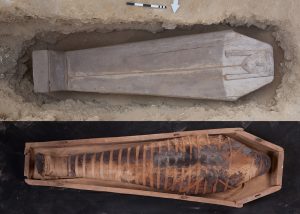In the first millennium BC, the mummification techniques were well advanced and versatile, but remained too expensive for many to preserve their bodies in such way in preparation for eternal life. Most commonly observed practice was very basic and included body desiccation followed by linen wrapping, occasionally with decorative pattern made of linen bandages. The bodies were inhumed in an extended position, face up, with the head towards the north or west.

Phot. Wojciech Wojciechowski/PCMA
Some individuals, or their families, could afford a wealthier burial, including a cartonnage, a coffin, and personal attributes, such as amulets, bracelets or necklaces. By equipping the deceased with the figurines of deities (made of wood or bronze), he or she was believed to have been under the gods’ care. Numerous such objects have been discovered in the Upper necropolis, e.g.:
